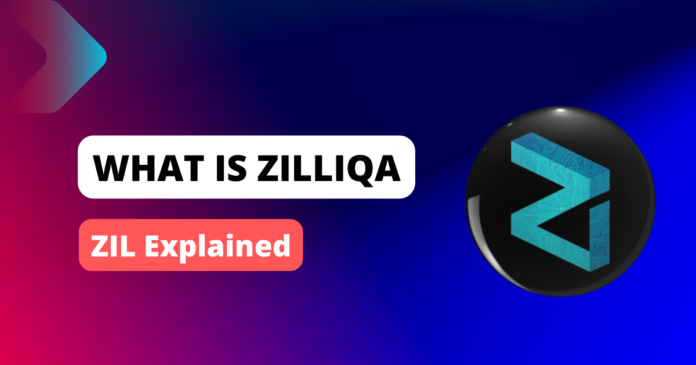What is Zilliqa? In this article, we’ll go through what Zilliqa is, who created Zilliqa, how it works, and what is ZIL and I’ll of course share my thoughts on it.
What is Zilliqa?
Zilliqa is a permissionless, open platform for innovative contracts. With the help of its sharded architecture, Zilliqa is one of the blockchain networks attempting to resolve the blockchain trilemma. The main objective of the project is to solve the scalability problems that most blockchain networks have. It enables many parallel chains to validate and execute transactions enhancing network speed and overall capacity. It was founded in 2017 by a team of researchers from the national university of Singapore and claims to be a thousand times faster than Ethereum. It was one of the first blockchain networks in the world to use a sharded architecture.
It implements a hybrid consensus technique in addition to its unique sharding technology. It’s a hybrid of proof of work and practical byzantine fault tolerance or PBFT.
Who created Zilliqa?
Zilliqa was founded in 2017 by Xinshu Dong, Yaoqi Jia, Amrit Kumar, and Prateek Saxena at the time they were all researchers at the national university of Singapore. The team’s primary goal was to develop a platform capable of processing smart contracts at scale without jeopardizing basic blockchain features such as decentralization. Sharding was determined to be the best approach for achieving this goal. As a result, Zilliqa puts sharding theory into practice through its protocol to address the scalability issue.
In June 2017 the project was incorporated as Zilliqa research. In August of that same year, the white paper was published. Zilliqa is built on its proprietary programming language scilla. Its source code was released in January 2018 and the final test net was launched in November at the end of the year. The network’s Mainnet was formally established in January 2019.
How does Zilliqa work?
The most notable characteristic of Zilliqa is its reliance on sharding technology to address excessive congestion. Sharding is the division of a network into separate clusters of nodes, these node clusters are known as shards and can process transactions concurrently. As a result rather than the entire network processing a single transaction separate fragments process several trades simultaneously. The greater the number of shards in the network the faster the transactions.
Achieving consensus has been one of the most prominent problems with sharding technology. In classic blockchain networks such as bitcoin transaction verification requires the consent of half of the nodes, such an arrangement would be rather inconvenient on a sharded network with nodes spread out over numerous shards. Fortunately, Zilliqa provides a solution to this dilemma. Its hybrid consensus approach delegated transaction verification to the shard level. Individual flakes can thus not only process but also verify transactions.
Furthermore, Zilliqa has introduced a second degree of verification to confirm its legitimacy. The directory service or DS committee is a group of nodes in the second layer. The DS committee has full access to the blockchain and may readily confirm whether or not the verification is authentic.
Zilliqa has also teamed up with chain link to give real-world data access, oracles will be used to do this. These oracles will allow Zilliqa smart contracts to import data from sources other than their network. Similarly, this adds another layer of protection to the network, because various nodes will deliver the data there will be no single point of failure or attack.
What is ZIL?
ZIL is the Zilliqa platform’s native token it has numerous network utilities including the ability to execute smart contracts, pay transaction fees and act as a reward for minors. It’s also planned to be utilized as a governance token in the future. Initially released on Ethereum as an erc20 token the pass was later moved to the Zilliqa network upon the introduction of its main net. From December 2017 to January 2018 the first public cell of ZIL raised more than 22 million dollars. This deal was only open to members of the Zilliqa slack or telegram groups who joined before November 29, 2017.
The overall supply of ZIL is limited to 21 billion units. The platform occasionally distributes more zeal into circulation as prizes to miners and Stakers. The miners have been allocated 40% of the entire supply of ZIL.
Conclusion
What are my thoughts on Zilliqa? The primary worry with silica is the same as it is with all efforts attempting to address the blockchain trilemma. The main issue these so-called Ethereum killers face is the massive degree of competition. The initiative that emerges victorious from this competition will most likely wipe out all the others. Even Ethereum 2.0 may mark the death of all of these fledgling projects.
Related: What are WRAPPED Tokens? | Wrapped Token Explained
Another concern is that most new initiatives prefer proof of stake over proof of work, claiming that it’s far more efficient. Zilliqa employs a mixed proof-of-work consensus process and its long-term viability has yet to be seen. I hope you got value from this article, so what are your thoughts on silica leave a comment below.
Zilliqa is a permissionless, open platform for innovative contracts. With the help of its sharded architecture, Zilliqa is one of the blockchain networks attempting to resolve the blockchain trilemma.
Zilliqa was created by Xinshu Dong, Yaoqi Jia, Amrit Kumar, and Prateek Saxena at the national university of Singapore.
Zilliqa is a permissionless, open platform for innovative contracts. With the help of its sharded architecture.
ZIL is the Zilliqa platform’s native token it has numerous network utilities including the ability to execute smart contracts, pay transaction fees and act as a reward for minors. It’s also planned to be utilized as a governance token in the future.
The anticipated average price of ZIL for 2024 may be around $0.099. The expected range for the price of ZIL is $0.12 for the high and $0.087 for the low. Zilliqa will offer decent long-term investment opportunities.

